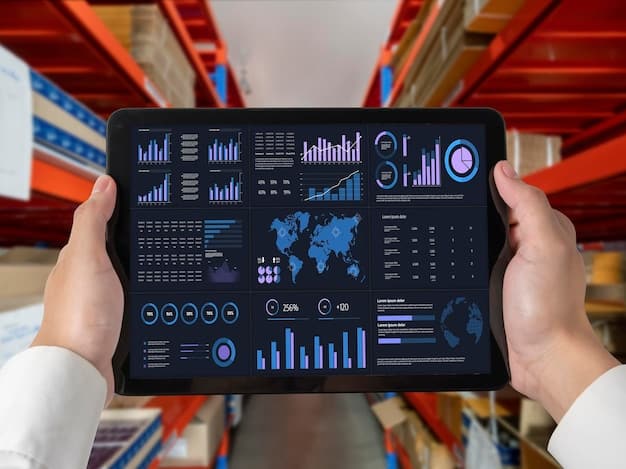E-commerce Inventory Management: Real-Time Tracking for 10% Stockout Reduction

Implementing robust e-commerce inventory management through real-time tracking can effectively reduce stockouts by a minimum of 10%, ensuring product availability and enhancing customer satisfaction in a competitive market.
In the dynamic world of online retail, managing inventory effectively is not just about counting products; it’s about strategic foresight. E-commerce inventory management: reduce stockouts by 10% with real-time tracking isn’t merely a lofty goal, but a tangible benchmark that progressive businesses can — and should — achieve.
The Core Challenge: Why Stockouts Haunt E-commerce
Stockouts, the bane of every e-commerce retailer, signify much more than just a momentary interruption in sales. They represent lost revenue, damaged customer loyalty, and a tarnished brand reputation. When a customer navigates to your site, eagerly finds an item, and then sees “out of stock,” the immediate reaction is often disappointment, followed by a swift departure to a competitor who can fulfill their need. This isn’t just a minor inconvenience; it’s a significant leak in the sales funnel that can undermine even the most robust marketing efforts.
Understanding the root causes of stockouts is the first step toward mitigation. Often, it’s a complex interplay of factors: inaccurate historical data, unpredictable demand spikes, inefficient supply chain communication, or simply a lack of real-time visibility into current stock levels. Traditional, manual inventory counting methods are prone to human error and are inherently reactive, offering insights only after a problem has materialized. In the fast-paced digital marketplace, such delays are unacceptable.
The financial implications extend beyond immediate lost sales. There are costs associated with expedited shipping to replenish stock, potential penalties from unfulfilled backorders, and the long-term impact of losing repeat customers. Moreover, stockouts can severely impact a business’s standing with search engines, as consistent product availability is often favored in rankings. Consequently, mastering inventory management becomes paramount for sustainable growth and a competitive edge in e-commerce.
The Hidden Costs of Unavailable Products
It’s easy to quantify a lost sale, but the true cost of stockouts runs deeper. They erode the trust customers place in your brand, leading them to question your reliability. A single negative experience can lead to a domino effect of negative reviews and word-of-mouth, deterring potential new customers. This intangible damage can be far more costly in the long run than any single transaction.
- Customer Churn: Frustrated buyers are unlikely to return.
- Brand Degradation: Perception of unreliability and inefficiency.
- Marketing Waste: Driving traffic to products that can’t be bought.
- Operational Inefficiencies: Rush orders and higher shipping costs.
Furthermore, without accurate inventory data, businesses cannot forecast demand effectively. This leads to a vicious cycle: ordering too little results in more stockouts, while ordering too much leads to overstocking, tying up capital and incurring storage costs. Both scenarios negatively impact profitability and operational agility. Therefore, a proactive approach to inventory management is not merely beneficial, but absolutely essential for the modern e-commerce enterprise.
Real-Time Tracking: The Cornerstone of Modern Inventory Management
The concept of real-time tracking is a paradigm shift in how e-commerce businesses manage their inventory. It moves away from periodic, manual checks to continuous, automated updates, providing an up-to-the-minute picture of every product’s location and quantity. This digital transformation is powered by advanced technologies that integrate seamlessly across the entire supply chain, from warehouse to customer doorstep.
At its core, real-time tracking means that as soon as an item is sold, received, transferred, or returned, its status is immediately reflected in the central inventory system. This instantaneous update eliminates discrepancies that often arise with batch processing or manual data entry. For e-commerce businesses, this translates into unprecedented accuracy, allowing for informed decision-making regarding purchasing, merchandising, and fulfillment. Businesses can now allocate resources more effectively, anticipate demand fluctuations, and respond swiftly to market changes, rather than being caught off guard.
Indeed, real-time tracking isn’t about mere surveillance; it’s about empowerment. It empowers businesses to offer accurate stock counts on their websites, preventing customers from ordering unavailable items. It empowers fulfillment teams to pick and pack orders with confidence, knowing the product is actually in the warehouse. And most importantly, it empowers strategic planning by providing granular data that was previously unattainable, fostering a culture of proactive inventory optimization.

Leveraging Technology for Instant Insights
The backbone of effective real-time tracking lies in sophisticated technological solutions. Barcode scanning and RFID (Radio-Frequency Identification) tags are fundamental, enabling quick and accurate data capture at various points in the inventory lifecycle. These are integrated with Inventory Management Systems (IMS) or Enterprise Resource Planning (ERP) software that act as the central nervous system, processing and disseminating information.
Moreover, cloud-based platforms have revolutionized accessibility, allowing inventory data to be accessed from anywhere, at any time, across multiple devices. This fosters collaboration among different departments—sales, marketing, warehouse operations, and customer service—all working with the same, up-to-date information. Predictive analytics, often integrated into these systems, takes real-time data a step further by forecasting future demand based on historical trends, seasonal variations, and external factors, further fine-tuning inventory levels.
- Barcode/RFID Scanners: Swift and error-free data collection.
- Cloud-Based IMS/ERP: Centralized, accessible data for all teams.
- Automated Stock Updates: Eliminating manual discrepancies.
- Predictive Analytics: Forecasting demand for proactive stocking.
The result is a streamlined operation where inventory is always optimized, minimizing both overstocking and understocking. This newfound precision directly contributes to the stated goal of reducing stockouts, thereby significantly improving customer satisfaction and preserving crucial revenue streams. The continuous flow of accurate information transforms inventory management from a reactive chore into a strategic asset.
Achieving the 10% Reduction: A Practical Roadmap
The goal of reducing stockouts by 10% through real-time tracking is ambitious but entirely achievable for e-commerce businesses committed to operational excellence. This isn’t a one-time fix but rather a continuous process of refinement and optimization. It begins with a thorough audit of current inventory practices, identifying bottlenecks and areas where real-time data can make the most significant impact. Transitioning to real-time tracking requires a strategic approach, encompassing technology adoption, process re-engineering, and staff training.
First, investing in the right real-time tracking software and hardware is crucial. This means selecting a system that integrates seamlessly with your existing e-commerce platform, accounting software, and shipping carriers. The chosen solution should offer robust features like automated alerts for low stock levels, comprehensive reporting, and user-friendly interfaces. Secondly, standardizing inventory procedures across all touchpoints—receipt, storage, picking, packing, and shipping—ensures data consistency and accuracy. Every team member involved in inventory movement must be trained on how to use the new system effectively, understanding the importance of meticulous data entry and scanning.
Finally, continuous monitoring and analysis of inventory data are essential for sustaining and improving the initial 10% reduction. Regularly reviewing performance metrics such as stockout rates, inventory turnover, and order fulfillment times provides valuable insights for further optimization. This cyclical process of implementing, monitoring, and adjusting ensures that the benefits of real-time tracking are maximized over time.
Key Steps for Implementation and Optimization
Implementing real-time tracking efficiently involves several critical steps, each contributing to the overall success of the inventory management strategy. It’s not just about installing software; it’s about creating a culture of precision and responsiveness within the organization. A structured rollout plan can mitigate potential disruptions and ensure a smooth transition to the new system.
- System Selection: Choose a scalable, integrated IMS/ERP with real-time capabilities.
- Data Migration & Accuracy: Ensure existing inventory data is clean and accurately transferred.
- Hardware Deployment: Install necessary barcode scanners, RFID readers, or other data capture devices.
- Workflow Redesign: Adapt operational processes to leverage real-time data updates.
- Team Training: Educate all relevant personnel on the new tools and procedures.
- Pilot & Rollout: Implement the system incrementally if possible, learning from pilot phases.
- Performance Monitoring: Track key metrics to measure reduction in stockouts and other efficiencies.
Each of these steps reinforces the foundation for reduced stockouts. Regular reviews of inventory data, coupled with automated reorder points and intelligent forecasting, empower businesses to anticipate demand and replenish stock proactively. This proactive stance, driven by real-time insights, directly translates into fewer instances of “out of stock” notifications and a more reliable shopping experience for customers. The 10% reduction is not static; it is a minimum, often exceeded by businesses that fully embrace these practices.
Beyond Stockouts: The Ripple Effect of Real-Time Tracking
While reducing stockouts is a primary objective, the benefits of implementing real-time inventory tracking extend far beyond merely keeping products in stock. This advanced approach to management creates a powerful ripple effect, positively impacting various facets of an e-commerce operation. From optimizing operational efficiencies to enhancing customer experience and improving financial health, the advantages are multifaceted and contribute to overall business growth.
One significant benefit is the remarkable improvement in operational efficiency. With accurate, real-time data, warehouse staff can locate items faster, leading to quicker order fulfillment and reduced labor costs. Picking errors diminish significantly when inventory locations are precisely known. Furthermore, real-time insights enable more efficient space utilization within the warehouse, as businesses can identify slow-moving items and optimize their storage, freeing up valuable floor space. This efficiency directly contributes to a leaner, more agile operation, capable of handling increased order volumes without proportional increases in overhead.
Customer satisfaction reaches new heights not only from consistent product availability but also from faster, more accurate deliveries. When customers trust that an item listed as in stock is indeed available and will arrive promptly, their confidence in your brand strengthens. This leads to higher repeat purchase rates, positive reviews, and strong word-of-mouth referrals, all invaluable assets in the competitive e-commerce landscape. The strategic advantage gained from such comprehensive benefits positions businesses for sustainable success.

Operational Excellence and Customer Love Unlocked
Real-time inventory tracking acts as a catalyst for operational excellence. It allows for more precise demand forecasting, which minimizes both overstocking and understocking. When you avoid piling up excess inventory, you free up capital that can be invested elsewhere in the business, such as marketing or product development. Conversely, reducing stockouts ensures that potential sales are not lost, directly boosting revenue. This balanced inventory approach significantly improves cash flow and profitability.
Moreover, effective inventory management aids in identifying trends in product performance. By analyzing real-time sales data against inventory levels, businesses can identify top-selling items and those that are underperforming. This insight enables better purchasing decisions, helping to curate a product catalog that truly resonates with the target audience and maximizes profitability. It also facilitates more strategic promotions and clearance sales for slow-moving stock, preventing obsolescence.
- Reduced Holding Costs: Less capital tied up in excess inventory.
- Improved Cash Flow: Optimized inventory leads to better financial health.
- Enhanced Forecasting: Accurate data for better purchasing decisions.
- Greater Profitability: Maximized sales and minimized waste.
- Elevated Customer Trust: Consistent availability builds loyalty.
Ultimately, the ripple effect of real-time tracking is a virtuous cycle: improved efficiency leads to better customer experiences, which in turn drives increased sales and profitability. This holistic improvement validates the investment in sophisticated inventory solutions, transforming a necessary operational task into a powerful strategic advantage for any e-commerce enterprise.
Integrating Systems for Seamless Inventory Management
The true power of real-time inventory tracking is unleashed when it’s part of a fully integrated ecosystem of business tools. In the complex landscape of e-commerce, a standalone inventory system, no matter how advanced, will always have limitations. For optimal performance and maximum revenue impact, the inventory management system must communicate seamlessly with other critical platforms, creating a unified flow of information across the entire business operation. This holistic integration is what transforms mere data into actionable intelligence.
Key integrations include connecting the inventory system with your e-commerce platform (e.g., Shopify, Magento, WooCommerce), ensuring that website stock levels are always accurate and immediately updated upon sale or restock. Integration with accounting software (e.g., QuickBooks, Xero) automates financial reporting related to inventory value, cost of goods sold, and purchase orders, eliminating manual data entry and reducing errors. Furthermore, linking with shipping carriers and logistics providers streamlines the fulfillment process, allowing for automatic label generation, tracking number assignment, and real-time shipping updates for customers.
Another crucial integration point is with Customer Relationship Management (CRM) systems. When sales and customer service teams have access to real-time inventory data, they can provide accurate information to customers, manage expectations, and offer alternatives for out-of-stock items, significantly improving the customer service experience. This interconnectedness not only enhances efficiency but also provides a comprehensive view of the entire customer journey and product lifecycle, from initial inquiry to post-purchase support.
The Ecosystem of Connectivity: Unlocking Full Potential
Achieving this level of integration often involves using APIs (Application Programming Interfaces) or specialized connector apps that act as bridges between different software solutions. Many modern inventory management systems are built with open APIs, designed to facilitate such interoperability. The goal is to eliminate data silos, where critical information resides in isolated systems, hindering a comprehensive view of operations.
- E-commerce Platform Integration: Real-time stock sync for accurate online display.
- Accounting Software Integration: Automated financial reconciliation and reporting.
- Shipping & Logistics Integration: Streamlined fulfillment and tracking.
- CRM Integration: Enhanced customer service with accurate product availability.
- POS Integration (if applicable): Unified inventory across online and offline channels.
The benefits of such an integrated ecosystem are profound: improved data accuracy, reduced manual workload, faster decision-making, and a truly optimized supply chain. Businesses can respond to market changes with remarkable agility, knowing that every piece of information is consistent and synchronized across all departments. This robust connectivity is not just a technological convenience; it’s a strategic imperative for any e-commerce business aiming for substantial growth and a leading market position. It allows resources to be optimally deployed, contributing to sustained efficiency and profitability.
Future-Proofing Your E-commerce with Predictive Inventory
The evolution of e-commerce inventory management doesn’t stop at real-time tracking; it extends into the realm of predictive analytics. While real-time data provides an instant snapshot, predictive inventory management utilizes historical data, current trends, and external factors to forecast future demand with remarkable accuracy. This transition from reactive to proactive inventory strategies is crucial for long-term sustainability and maintaining a competitive edge in an ever-fluctuating market.
Predictive analytics goes beyond simply looking at past sales. It considers a multitude of variables such as seasonal fluctuations, promotional impact, competitor activity, economic indicators, and even social media trends. By feeding this diverse data into sophisticated algorithms, businesses can anticipate demand spikes or dips before they occur. This foresight allows for intelligent procurement, ensuring that the right amount of stock is on hand at the right time, minimizing both potential stockouts and costly overstock. Such a nuanced approach moves inventory management from a logistical task to a strategic competitive advantage.
Furthermore, integrating artificial intelligence (AI) and machine learning (ML) into predictive inventory systems allows for continuous learning and refinement of forecasts. As more data is collected and processed, the algorithms become more accurate, leading to even greater efficiency in inventory optimization. This ability to continuously adapt and learn makes the inventory system increasingly resilient to market volatility and unexpected events, thereby providing a robust foundation for future growth and innovation in the e-commerce sector.
The Role of AI and Machine Learning in Forecasting
AI and machine learning capabilities are transforming inventory forecasting from an art into a precise science. These technologies can identify subtle patterns and correlations in vast datasets that would be impossible for human analysts to detect. For instance, an AI might learn that a particular combination of weather patterns, social media buzz, and competitor pricing signals an impending surge in demand for a specific product, prompting proactive inventory adjustments.
- Pattern Recognition: AI identifies complex demand patterns.
- Demand Signal Processing: Integrates diverse data sources for forecasts.
- Automated Adjustments: System recommends or implements order changes.
- Risk Mitigation: Reduces the likelihood of both stockouts and excess inventory.
- Continuous Learning: Algorithms improve over time with new data.
This level of precision in forecasting empowers e-commerce businesses to optimize their supply chain on an unprecedented scale. Lead times from suppliers can be managed more effectively, production schedules can be optimized, and even pricing strategies can be adjusted in anticipation of demand changes. The result is a highly efficient, responsive inventory system that not only prevents stockouts but also maximizes profitability by ensuring optimal stock levels at all times. This forward-looking approach is vital for any e-commerce business aiming to not just survive, but thrive and lead in the fast-evolving digital marketplace.
| Key Point | Brief Description |
|---|---|
| 📊 Real-Time Tracking | Instant updates on stock levels, crucial for accurate customer information and preventing discrepancies. |
| 📉 Stockout Reduction | Aims for a minimum 10% decrease in stockouts, improving sales and customer satisfaction. |
| 🔗 System Integration | Connecting inventory with e-commerce, accounting, and shipping systems for seamless operations. |
| 🔮 Predictive Analytics | Utilizing AI/ML to forecast demand accurately, preventing both stockouts and overstocking. |
Frequently Asked Questions about E-commerce Inventory Management
▼
A stockout occurs when a product is ordered but is unavailable in inventory, leading to unfulfilled sales. It’s detrimental because it results in lost revenue, customer frustration, damaged brand reputation, and can push customers towards competitors, eroding long-term loyalty and market share.
▼
Real-time tracking provides immediate, accurate updates on inventory levels, minimizing discrepancies and enabling proactive reordering. This visibility allows businesses to set precise reorder points, fulfill orders without error, and respond swiftly to demand changes, directly contributing to a notable reduction in stockouts.
▼
Key technologies include barcode or RFID scanning for quick data capture, cloud-based Inventory Management Systems (IMS) or Enterprise Resource Planning (ERP) software for centralized data, and integration tools (APIs) to connect with e-commerce platforms, accounting, and shipping systems for seamless data flow.
▼
Absolutely. Beyond reducing stockouts, real-time tracking enhances operational efficiency by streamlining warehousing, optimizes cash flow by minimizing overstocking, improves customer satisfaction through accurate availability and faster delivery, and provides valuable data for better purchasing and product strategy decisions.
▼
Predictive analytics, empowered by AI and machine learning, is crucial for future-proofing inventory. It analyzes vast data to forecast demand with high accuracy, allowing businesses to proactively anticipate needs, optimize stock levels, and navigate market fluctuations more effectively than with traditional methods.
Conclusion
The journey to mastering e-commerce inventory management, particularly in the pursuit of reducing stockouts by a significant 10% or more, hinges on the strategic implementation of real-time tracking. More than just a logistical upgrade, it represents a fundamental shift towards a data-driven, proactive operational model. By embracing technologies that offer instant visibility into stock levels, businesses can not only mitigate the immediate financial losses associated with unavailable products but also cultivate deeper customer trust, streamline their entire supply chain, and unlock new avenues for growth and profitability. The sustained application of these principles, supported by robust system integrations and forward-looking predictive analytics, is what defines success in the competitive landscape of online retail.





